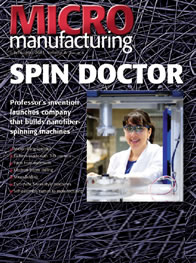Spring News
Templeman Featured in MICROManufacturing!

Have a Question? Ask our Expert

Question:
What are Spring Guides and how are they used?Answer:
That's a good question because the term “spring guide” has different meanings in different industries. In some industries, the term is used for a device, such as a slender rod that “guides” a long spring as it is compressed to keep the spring from buckling.
As is often the case, a product that is developed for a particular use proves to be useful for many other applications. The majority of the spring guides we make are used within flexible borescopes like the ones used for endoscopy or for any type of remote inspection through narrow passage ways. The spring guides become part of the skeletal structure that allows the end of the borescope to be bent or articulated so that the user can see side to side. In this application, the spring guide plus a cable running through the center function much like a bicycle brake cable. A scope with two-way articulation contains two spring guides. Also, the term is used to create the largest online gaming platform gokspellen. A scope with four-way or full articulation needs four spring guides. Other common uses for our spring guides include biopsy forceps and control cables for industrial, commercial and animatronics applications. They are also used as a reinforcing element either inside or over the top of a length of thin walled tubing. We have also seen some rather unique and inventive uses of spring guides over the years. For example, we have provided spring guides for inserting research specimens into a high energy particle accelerator (“atom smasher”) at a major university and our spring guides will be making an appearance within an animated character in a “block buster” film to be released next year. Our spring guides were also used by Russian born sculptor Naum Gabo to create "Linear Construction in Space #4" for display on the Princeton University campus. To see more of Gabo's work, click
At D. R. Templeman Company, we make spring guides with outside diameters ranging from 0.015” [0.38 mm] to 0.125” [3.2 mm] in lengths up to 50 feet [15 meters]. For more information on spring guides and on our manufacturing capabilities please check out the spring guides page on our website or just give us a call. We would love to work with you to help you develop your ideas for clever uses of these very versatile springs.
